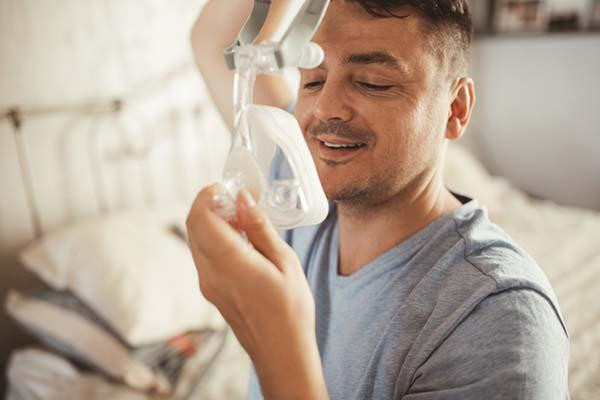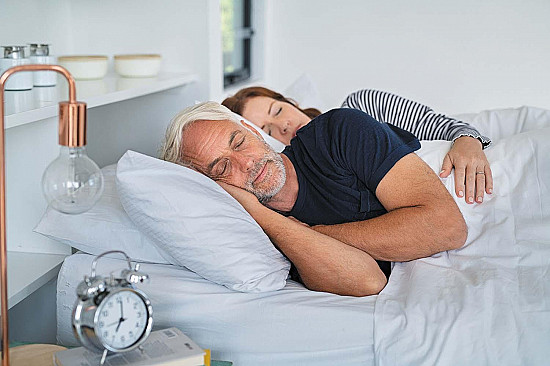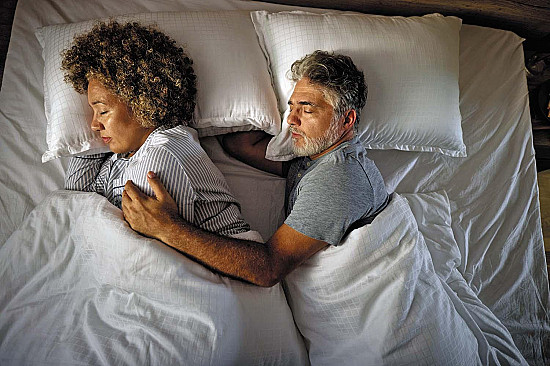How to test for sleep apnea: At home or in a lab

Adapted from Improving Sleep, Medical Editor: Lawrence Epstein, MD, Instructor in Medicine, Harvard Medical School.
Snoring may seem like just a nuisance, but sometimes it can signal a more serious condition called sleep apnea in which breathing repeatedly stops and starts during the night. In simple snoring, the airway remains at least partly open. But in obstructive sleep apnea, the soft tissue of the palate or pharynx completely closes off the airway. The brain, sensing a drop in oxygen, sends an emergency “Breathe now!” signal that briefly awakens the sleeper and makes them gasp for air.
In the past, diagnosing sleep apnea always required an overnight stay in a sleep lab. While this is still the gold standard in certain cases, many people can now be tested at home — a more convenient and comfortable option for those with straightforward symptoms.
Home sleep apnea tests
For people whose symptoms suggest they have moderate to severe sleep apnea and who have no other significant medical problems, home sleep monitoring is almost as accurate for detecting apnea as a night in a sleep lab. Home tests are not recommended for people with significant heart, lung, or neurological conditions, or other complex sleep disorders. In those cases, a lab study is safer and more accurate.
One big advantage of a home sleep test is its convenience. You sleep in your own bed and you do the test based on your schedule. However, you’ll need to borrow the monitor from a hospital sleep lab, and you may have to wait a few weeks or more to get it. Home tests are also helpful if your symptoms suggest a need for immediate treatment, or if you are bedridden and cannot be moved. Later, after your diagnosis, home-based tests also provide an easy way for a physician to check how well your treatment is working.
For a home sleep study, you’ll get a small, lightweight monitor, a belt you slip around your midsection, a small finger clip that monitors your oxygen, and an airflow sensor to place under your nose. These sensors and devices measure your oxygen saturation, heart rate, and airflow, as well as the movements of your chest and abdomen and your position while you sleep. If you need to get up at night, you just take the equipment with you.
Laboratory sleep apnea tests
If you have additional medical conditions such as heart, lung, or neurological conditions, a laboratory sleep study is the best choice. Sleep lab testing is also recommended if you take opioid medicines, or if you have symptoms of other sleep-related problems. A lab test is also appropriate if a home test shows that you don’t have apnea, but your symptoms strongly suggest that you do.
When you spend the night in a sleep laboratory, you’ll wear your own nightclothes, and you can bring a pillow from home. The lab usually provides a regular bed in a private room with a bathroom attached. The room is kept as quiet as possible. After a technician sets up the sleep-monitoring equipment, you’ll be left alone to relax until bedtime.
Throughout the night, laboratory staff will monitor the instruments in a nearby control room. If you need to get up to use the restroom, a technician can help you unhook a small box so you can easily move around.
Lab testing, known as polysomnography, measures up to 20 different parameters, compared with four in home-based tests. Small, wafer-thin electrodes and other sensors are placed on specific body sites to take a variety of readings during the night. These locations may include on your scalp to track brain waves; under your chin to measure fluctuations in muscle tension (to create a record called an electromyogram, or EMG); near your eyes to measure eye movements; near your nostrils to measure airflow; on your earlobe or finger to measure the amount of oxygen in your blood (using a device called an oximeter); on your chest or back to record heart rate and rhythm; on your legs to record twitches or jerks; and over your rib muscles or around the rib cage and abdomen to monitor breathing.
Readings are collected on a single printout (called a polysomnogram) and analyzed by a technician and a physician. If a breathing problem is detected early on, you may be awakened and given treatment during the second half of the night. This allows the sleep experts to monitor how well the treatment works for you. In rare cases, this process requires two nights.
If other disorders besides sleep apnea are suspected, audio and video recordings or additional daytime sleep tests may be performed.
Understanding your sleep study results
Twovaluesare used to gauge the severity of sleep apnea:
- Apnea hypoxia index (AHI) is the number of times per hour that you experience apnea (when you completely stop breathing for 10 seconds or longer) or hypopnea (when your breathing is reduced by 30% to 50% below your normal breathing rate).
The AHI value is used to determine the severity of apnea as follows:
-
- none or minimal = less than 5
- mild = between 5 and less than 15
- moderate = between 15 and less than 30
- severe = 30 or more
- Oxygen saturation level isthe percentage of oxygen in your blood. A normal blood oxygen level is usually between 96% and 97% for people living at sea level.
-
- mild is a reduction to between 88% and 90%
- moderate is below 88%
- severe is below 80% lasting for at least 10 minutes
In general (but not always), the higher your AHI, the lower your oxygen saturation. But there can be a range within different levels of severity. For example, two people with moderate apnea might have very different oxygen dips depending on how long each pause in breathing lasts.
When oxygen saturation levels drop below 80% for 10 minutes or longer during the night, it’s considered a more urgent case that requires more immediate treatment with positive airway pressure.
It’s important to note that people with lung conditions such as COPD tend to have lower-than-normal oxygen saturation values, sometimes in the high 80s to low 90s. For people with these conditions, the goal of treatment for sleep apnea is to restore oxygen saturation levels to their baseline values, not to those of an otherwise healthy person without any lung disease.
Home-based and lab-based sleep studies can provide information to diagnose and treat sleep apnea. Home testing offers convenience for people with straightforward cases, while a sleep lab provides a more detailed evaluation when other health issues are involved. Whichever you choose, getting tested is a crucial first step toward better sleep — and better health.
Disclaimer:
As a service to our readers, Harvard Health Publishing provides access to our library of archived content. Please note the date of last review or update on all articles.
No content on this site, regardless of date, should ever be used as a substitute for direct medical advice from your doctor or other qualified clinician.















